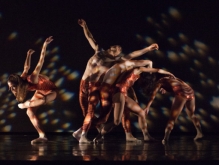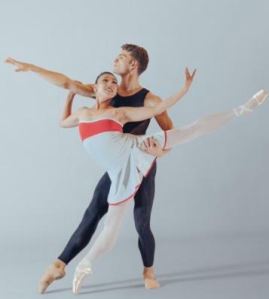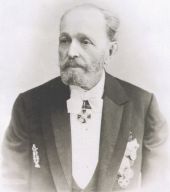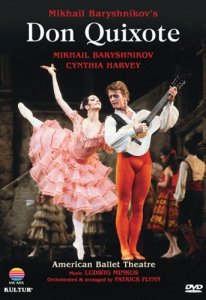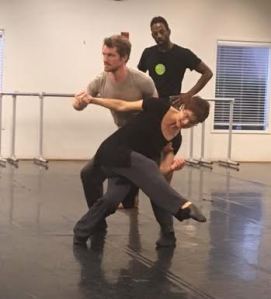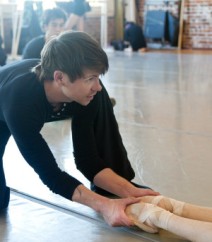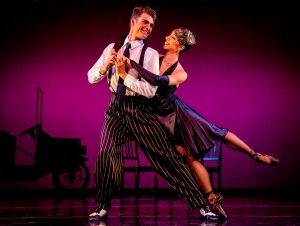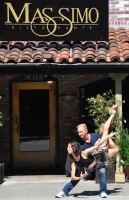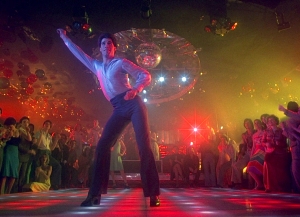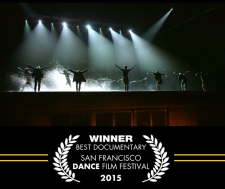By Diane Claytor
Las Lomas High School (Walnut Creek) graduating senior Caroline Fuller recently wrote her senior paper on this very topic. A former volunteer with Diablo Ballet, Caroline interviewed Lauren Jonas, the Ballet’s co-founder, as she researched her paper. When asked, Lauren said she “loves what Caroline wrote” and does, indeed, agree with much of Caroline’s conclusions.
“It’s an interesting time in ballet companies,” Lauren noted. “Getting people to spend their precious dollars on a new work, an unknown repertoire, something other than classical ballet, can be challenging.” But Lauren also believes that New York Ballet’s Misty Copeland and other dancers that are bringing more athletics to the dance form are bringing a new awareness of ballet to younger audiences. Caroline, who will be attending Occidental College in Southern California in the fall, represents the audience we’re trying to cultivate, Lauren said. Below is Caroline’s excellent senior paper.
Pointe Shoes and Tutus: A Fashion of the Past?
By Caroline Fuller
A man and a woman stand onstage. The music rises and the woman lifts her weight onto a single toe. With a paradoxical mix of grace and strength, the two, soon joined by others, leap and turn. As a dancer’s pink satin-clad foot reaches toward the sky and her muscular lower leg touches the side of her face, my own body aches. Hamstrings, feet, shoulders, and brain scream in protest of something that they know should not be humanly possible and yet is made to look so effortless. At the same time, my heart yearns with the dancer’s plight, the story she is telling with only her body.
Although I have never taken more than a beginner-level ballet class, I feel an intrinsic connection to ballet. Whether it is a longing for grace of my own or an admiration of ballet’s finesse and grandeur, the art form speaks to me on a personal level. Still, I have often downplayed my love of ballet in fear of judgment from my peers. For as much as I love ballet, I realize that there are large numbers of people who either know nothing about it or turn their nose up at it in disdain.
Because of this, I began to wonder whether ballet was a fashion of the past. A fellow teenager’s reaction upon hearing that I had taken a hip-hop class contained genuine awe and intrigue, while my telling of the ballet class I had attended was received politely, yet with distinctly less interest. Even in the dance world itself, ballet seems somewhat passé. Young dancers-in-training act as though ballet class is a chore, necessary for technical training, but unexciting and much less preferred than contemporary or jazz. Over and over again, I was confronted with ballet’s tribulations in modern society, leading me to my question: Is classical ballet a dying art form?

Dancer Marie Taglioni, about 1850.
When starting my research, I was pleased to find an explanation for my feeling of society’s increasing discomfort with ballet. In the 18th century, Louis XIV linked ballet to aristocracy and class while helping it grow into a full-fledged art form with distinct conventions and technique. Since then, ballet has retained many of its aristocratic ideals, but perhaps these ideals are contributing to its modern unpopularity. Louis’s airs and manners of the high court are no longer as esteemed as they once were. Hence, Jennifer Homans, author of Apollo’s Angels: A History of Ballet, explains that ballet has become associated with “dead white men and society ladies.”
Today, equality is touted as society’s aim, and ballet, an art of competition, is struggling to keep up. Traditionally, aspiring dancers go through years of intense training before they fight for coveted professional positions. However, there is a growing belief that dancers with specialized training should not cause those with more limited resources to be overlooked. What Homans terms the “we are all dancers now” mentality may be hurting the level of professional dance. However, I believe that this push for equality can only benefit ballet’s appeal in mainstream culture. A mesh of history, grandeur, and modern day ideals of equality will allow ballet to be more widely accepted.
On a rainy afternoon, I entered a business complex in downtown Walnut Creek to meet with Lauren Jonas, Diablo Ballet’s artistic director. Jonas opened her office door with a kind smile, welcoming me into the cozy room. Past and future performance posters and flyers lined the walls around our two comfortable chairs…Jonas sat down to talk with me, stating her belief that now, more than ever before, ballet and dance as a whole are at the forefront of mainstream society.

American Ballet Theatre’s Misty Copeland
For example, Misty Copeland, American Ballet Theatre’s first African-American principal dancer, is a well-known public figure. Her contribution to ballet’s diversification is lauded all over the media. Following her signing as ABT’s first black principal in the prestigious company’s history, Copeland could be found on talk show interviews and magazine covers. Most notably, she poses as the central female model for Under Armour, a sports clothing brand, alongside NBA player Stephen Curry. A 2014 commercial entitled “I Will What I Want” shows Copeland dancing in Under Armour attire over a monologue track of a girl reading a ballet academy rejection letter. The letter states that the girl is too old and that her body type is inapt for ballet. Clearly, the commercial shows that Copeland’s hard work allowed her to defeat the odds and the naysayers, a story that resonates with many. In the near future, I find it likely that diversity in ballet will only grow.
According to Gia Kourlas in a 2015 article for the New York Times, greater diversity in a company’s dancers leads to greater diversity in its audience members, which could combat the decreasing audiences from lack of faith in the art form’s ideals. In my opinion, diversity in performers is one of, if not the, primary cause of diversity in audience members. Generally, I believe that people enjoy seeing a reflection of themselves and their own culture in a performance, and are more likely to enjoy ballet if able to do this.
Kourlas noted that the lack of diversity and equality in ballet education is something that many companies are working to change with outreach programs sprouting up all over the nation. The schools at American Ballet Theatre, New York City Ballet, and Miami City Ballet, among others, have instituted programs to recruit minority dancers at young ages.
Specifically, Miami City Ballet’s program “Ballet Beyond Borders” provides scholarships to Central and South American dancers. Mayumi Enokibara, a Brazilian girl, left her home and family behind at age 14 in exchange for a scholarship at Miami City. If she had stayed in Brazil, Enokibara said, she would have gone to college due to the lack of arts opportunities. Instead, after four years in training, Enokibara achieved her dream of getting a contract with Miami City Ballet and now tours worldwide with the company.

Miami City Ballet’s Brazilian dancers, Mayumi Enokibara and Luis Fernanco-Silva Photo: Mitchell Zachs
Efforts like these to foster diversity in the art form will ideally counteract the inability for students with limited resources to get top-level training and subsequent professional careers. Although it may take time, I believe that the significantly increased number of outreach programs gives hope for a diverse future in classical ballet.
In all my research, one quote stuck with me: Alastair Macauley wrote in The New York Times in 2011, “Ballet had a beginning… it may well therefore have an end.” Since its birth in the Renaissance, classical ballet has been transformed many times by people and culture. Artistic masters from Russia to Western Europe to America have contributed their ideas and visions to the canon. But now that the 20th century masters, most notably the Russian-born New York City Ballet choreographer George Balanchine, are gone, some argue that ballet has entered a steep decline.
Contrary to what I had assumed, however, Homans reports that the supply of ballet dancers is as large as ever. Ballet continues to be a competitive field in which up-and-coming dancers vie for company contracts. What may be decreasing, on the other hand, is innovation. Many companies appear to be caught up in the 20th century. After Balanchine’s death, his repertoire became controlled by a trust which rents his works out to companies that apply to stage one of his shows. As a result, Balanchine’s ballets are seen across the world as much as they are in his native New York, and the focus on restagings and revivals is not limited to this one choreographer. Major companies are struggling to preserve the classics of the 20th centuries, bringing in more reconstructors, notators, and directors than they are hiring original choreographers.
Additionally, technology has greatly influenced repertoire preservation. Complicated traditional notation systems are unnecessary when dances are able to be recreated from film. However, this may be more detrimental to ballet’s innovation than suspected. In her book, Homans compares use of film in dance to watching a movie before reading the book. The artists are unable to detach themselves from the version they have seen on film, and the ability for reconstructions of previous ballets to be reinvigorated by new interpretations and unique styles is lost.

Diablo Ballet’s Robert Dekkers
In between his rehearsal times, I was able to speak about this with Robert Dekkers, the resident choreographer for Diablo Ballet, who explained the advantages of restagings, which constitute approximately half of Diablo Ballet’s performances. Oftentimes, he said, companies are faced with limited funds. The choreography, music, costumes, and multiple other expenses required for new works make restagings more realistic and common. While volunteering at a Diablo Ballet performance, I helped sell wine bottles, decorative pointe shoes, and other items post-show. It was clear that the company works in every way it can to acquire funding.
When faced with these facts, it is impossible for me not to see the pessimistic view of ballet’s future. A lack of forward movement, in this case related to a longing to retain history and a financial inability to foster new works, is rarely a good sign. For an art form such as ballet, these symptoms often signify a decline and eventual coming to a close. However, Jonas said the common classic works such as The Nutcracker, Swan Lake, and Sleeping Beauty are selling as much as ever.

A New York City Ballet performance of Swan Lake
During our interview, Jonas helped me understand the nature of ticket sales. Mixed repertoire shows, she said, which consist of both classical and contemporary pieces, are more difficult to sell. Casual ballet viewers more commonly attend classical works because they are familiar and known while mixed repertoire shows require the ticket buyer to take a gamble.
With respect to this, Ballet Austin, Texas’s largest ballet company, recently conducted research to address the question of ticket buyers’ hesitancy to attend new productions. The company created focus groups of ticket buyers and gathered over 1500 responses to a survey regarding viewer preference. Similarly to Jonas’ beliefs, Ballet Austin found that many people were wary of attending a show to which they would have an unsure reaction.
From this research, I was able to see that ballet’s inability to detach from the past is related not only to the performers and innovators within the art form itself, but also the audience members. Perhaps companies are fearful of leaving the famous works behind in favor of new works because they do not want to risk the loss of ticket sales. Could ballet be dying because society is unable to allow it to grow?
In response to this question and the aforementioned research, a recent audience survey conducted by Diablo Ballet showed that an equal number of audience members prefer classical and contemporary pieces. This implies that ticket buyers are not opposed to unknown work. With audience education, it is likely that new works would sell as well as the classics.
Ballet Austin has started multiple programs to address the gap between new works and viewer uncertainty. The company has found that there are two key elements in relation to a performance: a social connection and an intellectual and emotional one. More than anything, the intellectual and emotional connection suffers when ticket buyers are uncertain about what they are seeing onstage. Ballet Austin’s initiatives to strengthen this connection are focused on providing audience members with greater ballet knowledge.
First, the company began filming dance rehearsals and live-streaming them online, allowing people to see a sort of preview of the performance or an idea of what to expect. Additionally, Ballet Austin began a program called “Ballet-O-Mania,” a pre-show exhibit designed to educate and excite ticket buyers. The interactive exhibit allows ticket buyers to talk to company personnel, attempt dance moves, and generally learn more about the art form and what they are about to watch. As a whole, the initiatives are intended to give audience members a greater understanding of ballet. After instituting these programs, Ballet Austin surpassed its ticket-sale goals for two subsequent mixed repertoire shows.
This research makes me optimistic for ballet’s future. It shows that with effort to connect to and educate viewers, companies may be more likely and able to extend their repertoires past the well-known classics. However, this does not mean that the classics will ever be completely dead because, as Amanda Farris, dancer for Diablo Ballet, stated in an interview, “People want the pointe shoes and tutus.” Rather, my research has allowed me to envision a near future in which ballet’s past and present are able to coexist and to be appreciated equally by ticket buyers with the help of a small amount of audience engagement and education.

A scene from the English National Ballet’s production of The Nutcracker
In some cases, this vision is already more of a reality than not. The English National Ballet recently put on a full-length production of The Nutcracker with new choreography, but the original musical score. The Birmingham Royal Ballet did the same with Cinderella, and both ballets were well received by critics and audiences alike. Thus, tradition meets innovation, giving audiences the comfort and familiarity of a known work while still allowing innovation and creativity to flourish.

The Tea Party from the Royal Ballet’s production of Alice’s Adventures in Wonderland
Similarly, in 2011, the Royal Ballet premiered Alice’s Adventures in Wonderland, its first entirely new full-length work in 16 years. Unlike new works which scare off ticket buyers with unfamiliarity, this work was aided by its commonly known narrative and was widely praised. Clearly, companies are finding ways to foster new works without alienating ticket buyers, leading me to believe that classical ballet is in no way dead or dying.
From humanity’s beginning, movement of the body has served as a manner of expression and communication. There is no reason why ballet, one of the oldest and richest forms of this movement of expression called dance, should have to die now. The simple fact that my central question—is classical ballet a dying art form?— is a topic of debate in the dance world itself is a reason for hope. Growing awareness of ballet’s adversities in the modern world can only mean that its supporters are ready to wake it from its current slumber.
However, this process, along with the process of diversification and the resurfacing of classical ballet in mainstream culture, will no doubt be arduous. I do not believe that we can expect ballet tomorrow or even next year to be the societal phenomenon that it was in its heyday. Rather, classical ballet’s ideals, with the help of outreach programs, will catch up with modern society’s, and the inspiring stories of dancers such as Mayumi Enokibara and Misty Copeland will seep into our hearts until we are able to fully embrace the art form again.
















